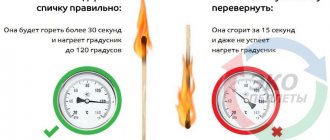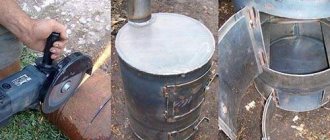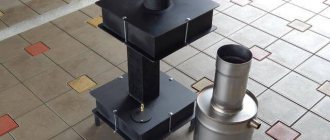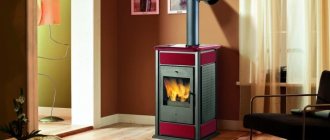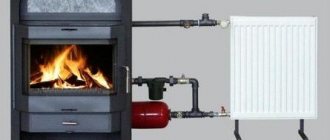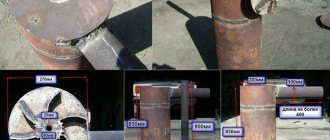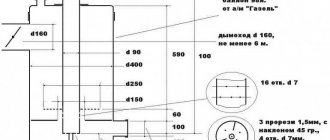What is a pellet stove?
A pellet stove is a convenient device for heating a room. No worse than a stove for heating a house. It uses pellets as fuel, which are modern, environmentally friendly and prepared in a special way in the form of fuel granules. On the modern market, pellet manufacturers make it from:
- sawdust
- peat
- potato waste.
- sunflower husks.
- straw.
- pellets.
According to experts, in the near future pellets will be able to take a leading position in the form of fuel for fireplaces and stoves.
Types of equipment for using pellets
Pellets are used as fuel both in private country houses and in industrial premises. The choice of equipment depends on the heating area.
Mostly used today are pellet boilers and stoves, which are sometimes called fireplaces by sellers.
Pellet stoves (fireplaces)
Pellet fireplaces are usually installed to heat one single room or a house with a small living space. The power of such devices ranges from 6–15 kW. Modern pellet stoves are divided into three types:
- convection ovens, which are capable of heating exclusively the surrounding air;
- devices additionally equipped with a water circuit for heating not only air, but also water;
- combined stoves, which, along with pellets, can also use briquettes with sawdust or ordinary dry firewood.
Pellet boilers
In large country cottages, as well as in industrial enterprises, boilers are installed as heating devices using pellets. Their power varies between 15–100 kW. If the installation of pellet boilers takes place in a private house, then the optimal place for their placement is the basement. There are several types of such devices:

- boilers operating exclusively on wood pellets;
- systems that, in emergency cases (if a burner fails, for example), allow sawdust or dry firewood to be used as fuel; for such interchangeability, the equipment is equipped with a special grille;
- Combination boilers that allow you to use not only wood pellets, but also firewood with briquettes.
Operating principle of a pellet stove
Pellet stoves are equipped with a special tank for a certain number of pellets. Pellets can be stacked on the side or on top. There are some differences: if pellet stoves are loaded from above, then their productivity is greater, but the quality of the pellets must be high. Side-loading pellet stoves require such a fastidious attitude to the quality of fuel.
The volume of the pellet loading tank may vary. The duration of operation of the furnace, as well as the frequency of loading fuel into the tank, depends on this. For most home and garden stoves, the standard period of operation without adding fuel is several days. The pellet stove has a control unit that regulates the intensity of the flame. You can use a thermostat that will be connected externally. During regular use, it will be necessary to clean the ash pan of the pellet stove at intervals of 1 week.
Is there any point in doing this?
Often, a person who wants to install such a unit in his home is faced with the question of whether he needs to assemble a pellet stove with his own hands or whether it is best to purchase a ready-made option. It must be remembered that in the first case, a person will be able to create a unit that will fit the existing conditions in all respects, and in the second, he will have to use a structure that is ready for use, but does not take into account the individual characteristics of the room. If doubts are caused by the type of fuel used, then you need to know that pellets are a type of processed wood and agricultural waste, which makes the fuel efficient in terms of heat generation, but economical in cost. Such a homemade stove is environmentally friendly because:
- does not pollute the air;
- does not contain harmful components in vapors;
- do not require special fuel supplies, which eliminates the need to cut down trees.
Types of pellet boilers
Heating equipment of this type is classified based on different criteria
According to the materials from which the structure is made
Most fireplaces are made from high-quality steel. Much less common are devices whose main material is cast iron.
By type of burner
There are ovens:
- flare; the most popular “household” option; Flare boilers are characterized by low power, ease of operation and adjustment, and reliability; Among the disadvantages of this type are sensitivity to fuel quality and unidirectional heating of the stove walls;
- fireplace; characteristic feature - the granules are burned in a special pellet bowl; there are fewer adjustment possibilities, and there is also a greater demand for fuel; but such stoves can be installed in rooms - the equipment is quiet and safe;
- volumetric combustion; Much more often, such burners are used in industrial-type devices, but they also have a place in household units; minus – increased bulkiness; advantages - higher power and undemanding requirements for granules (in Russian realities, the latter aspect is of considerable importance).
By fuel supply type
Furnaces are divided into:
- mechanical; the operator of such a boiler turns into a stoker, forced to constantly monitor the combustion process;
- semi-automatic; Only power is set manually here - the rest of the control falls on the shoulders of the automation; from the point of view of cost-quality ratio, this option is preferable to others;
- automatic; The user only needs to load the fuel - the automation will do the rest; but for the initial setup of the equipment, it is better to call specialists - they will make all the necessary calculations based on the size of the room, the required temperature and other parameters.
By fuel type

Pellet boilers operate on different types of fuel. There are ovens:
- working exclusively on wood pellets; in the absence of the ability to regularly provide yourself with compressed fuel, there is no point in purchasing such equipment; Even at the stage of choosing a furnace, it is necessary to consider options for supplying granules of a suitable type;
- partially combined; the use of briquettes and firewood is allowed - this is facilitated by the format of the firebox; but the main role of fuel is played by pellets, while other options serve as a help in situations where there is no access to pellets; ignoring this rule leads to equipment failure;
- combined; these units have several fireboxes of various formats; therefore, it is allowed to use both pellets and firewood with briquettes on a regular basis; The disadvantages of combined devices are the high price and decent dimensions.
By purpose
Depending on the purpose, equipment is divided into:
- convector fireplaces; their task is to heat the air; the most popular option - such stoves take up little space, have the “right” to be placed in residential premises and easily “get along” with any interior design;
- water heating boilers; distinguished by their solid size and inexpressive appearance; they are usually installed in utility rooms or basements;
- hybrid units; the task of combined devices is both direct heating of air and heating of the coolant; in terms of design they are close to convection equipment.
Fuel benefits
Going through all stages of production, this type of fuel not only increases its density, but also reduces humidity to 8-12%. The latter indicator plays an important role in the combustion process. Fuel with low humidity releases more thermal energy, hence the high efficiency. More complete combustion occurs with low ash content.
For comparison, we present the amount of heat released during the combustion of 1 ton of different types of fuel.
- 3500 kW/h - pellets;
- 7000 kW/h - hard coal;
- 2000 kW/h - firewood;
- 10,000 kW/h - gas and diesel fuel.
In fact, inexpensive pellets are better than firewood, but produce less heat compared to other types of energy sources. But here price comes into play.
Advantages and disadvantages of pellet boilers
The popularity of pellet boilers is growing due to a series of advantages. Among them:
- efficient heat transfer; The efficiency of such devices is comparable to the efficiency of gas heating devices and is significantly higher than the efficiency of wood-burning stoves;
- fuel efficiency;
- complete environmental friendliness; absence of any harmful substances in the granules;
- autonomy; provided there is an automated system, the user is deprived of the need to control the combustion process - the automation does almost everything for the person;
- independence from main power systems;
- almost complete non-waste - when burned, the granules leave a very small amount of ash; cleaning the ash pit is rarely required;
- equipment safety and no need to coordinate installation with the relevant services;
- aesthetic design of boiler-fireplaces - the ability to “fit” the unit into any interior.

is not without its drawbacks. These include:
- the need for electricity, without which ignition of fuel, operation of the auger and control unit are impossible;
- high cost of equipment; average price range – 100,000-1,000,000 rubles;
- dependence of European models on Russian energy systems and pellet quality; devices can be sensitive to power surges and require fuel; When choosing a stove, you should definitely consider protection against voltage surges and the possibility of purchasing pellets suitable for a specific model.
If you have the financial means, the advantages of stoves outweigh their disadvantages
Comparison with similar devices
The cost of electricity, as well as gas, is constantly growing, which means that pellet stoves are profitable to buy, first of all, from the point of view of benefits.
We recommend: Warm water floor

Since they are completely independent of external sources, the system’s dependence on suppliers automatically disappears - the home owner himself decides how much pellets he needs to purchase, for example, for one winter season.
Main differences
The main difference between fireplaces using wood pellets and stoves using dry wood is that they do not emit carbon dioxide. When wood burns, it releases carbon dioxide, and this is very dangerous for the health of the inhabitants of a country house. The ash that is formed after the combustion of pellets can be used as fertilizer on the site or in the greenhouse.
Another distinctive feature of such devices is that they can be installed in homes when there is no gas pipeline nearby or the possibility of heating using an electric unit. Moreover, even if both gas and electricity are available, if they are turned off, the pellet stove will be a backup system for heating the cottage. This is especially true in extreme cold. With proper operation of such furnaces and timely maintenance work, they can last more than 20 years.
Institutional use
The popularity of installing pellet stoves in restaurants, shopping centers, industrial premises, hotels and social institutions (hospitals, schools, kindergartens) is understandable.

The fact is that compared to gas heating, heating rooms with pellets is approximately 2 times cheaper, and if we talk about electric heating, the economic benefits can increase by 3-4 times.
Hardwood firewood for heating the stove
Deciduous trees are considered one of the best for use as firewood, but each tree of this type has its own thermal characteristics.
- Oak firewood. They have a solid structure, a long burning period, and excellent heat transfer. We can say that oak, due to its properties, is one of the most suitable for preparing firewood. Despite the fact that oak is quite expensive to purchase, it is economical and consumes more slowly than other firewood. The price is quite consistent with the thermal characteristics.
- Middle-aged oak trees are excellent for stoves; it is this wood that has optimal properties. Young oak trees have a small amount of heat, and they also fill the air with the smell of coal. If you burn with old oak, the amount of ash will increase significantly and the air will be heavy from it.
- During combustion, oak wood emits hot fire and tart forest smoke. When the fireplace is heated with oak logs, a healing atmosphere is created in the room. The healing qualities of oak logs have already been proven. Original Italian pizza is prepared only on oak wood. Moreover, in Italy it is difficult to find oak logs; they are “worth their weight in gold” there.
- Birch logs. They have special valuable qualities that people have known about since ancient times. Birch firewood is especially suitable for heating sauna stoves. With the help of birch heat, you can disinfect rooms; a wonderful aroma emanates from birch. Such firewood burns for a long time and produces a high, even flame; the fire does not spark. If you take a steam bath heated with birch firewood, colds and many chronic respiratory diseases will go away. However, here we must take into account such a property of birch as the loss of its valuable medicinal qualities just a couple of years after the birch is cut down for firewood. The fact is that birch logs become outdated quite quickly. When the log becomes rotten, such a hot fire will no longer be possible. Birch bark and the wood itself contain a lot of tar. It is a carbon compound due to which birch quickly ignites and burns intensely. This property is used to make splinters for lighting “heavy” wood. Birch has a heat transfer coefficient that is about a quarter higher than that of aspen or pine. However, the fact that birch leaves a lot of soot hinders the constant use of birch logs. Chimneys will have to be cleaned much more often.
- Alder logs. The structure of alder wood is very beautiful in color. It can be ocher, orange, bluish or even bright red. There are more than 25 species of alder, and each has its own shade of color. Alder logs can be stored for a long time, that is, they can be stored for future use for several years to come. For harvesting, as a rule, they choose places in forest areas where humidity is low, away from rivers or lakes, which is where the wood is more suitable for kindling. Alder also has a fragrant smoke that can be heard for about three years after the tree is harvested. Alder retains all other properties much longer. When burning, the heat transfer is very high, the logs almost do not smoke. In the old days, alder was used to heat a black bathhouse. On a note. When burning alder logs, the chimney ducts of the stove are cleared of soot. It is good to use alder firewood for a smokehouse; you get very tasty smoked meats. Therefore, when preparing firewood, there is no need to throw away sawdust; they will come in handy. Alder should be harvested in winter, since it is impossible to get close to it in summer - it loves swampy places.
- Linden logs. They are valued for their intense combustion and quick heating of the stove. However, it is difficult to light a linden tree; many people know this feature. Linden has the same healing properties as birch; they are successfully used to kindle baths. Once upon a time, several grams of honey were added to linden firewood and this was how they treated lung diseases and old wounds that did not heal for a long time. Linden has strong healing properties, but they last no more than two years after cutting. And this is considered the only drawback of linden logs.
Bird cherry or rowan logs like poplar and willow are classified as small-leaved species. This is low quality firewood that produces little heat. Is it possible to heat a stove with bird cherry? Yes, only if you got it for free. Paying for low-grade wood—even very low prices—is overpaying. Such firewood will burn quickly, and you will have to add such logs to the firebox much more often. But there is no harm from such wood either. That is, the only drawback is that a large amount of firewood is required.
Practical recommendations
Before you start assembling a pellet fireplace stove, you should decide what parts you need to purchase - we are talking about the burner and industrial automation. You should not experiment and assemble the burner yourself. Even if a lot of effort is put into it, its functionality may be very questionable.
It is best to purchase ready-made elements and use them later when assembling a pellet stove. If you make the boiler multifunctional, that is, provide it with a water circuit and the ability to work both on pellets for the fireplace, and on wood and coal, then in the future it can be modernized.
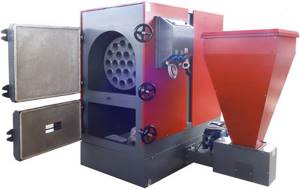
It is worth noting that heat exchange in these types of heating will differ only in the type of solid fuel and the method of its combustion.
The advantages of a universal boiler will be:
- If there are interruptions in the supply of pellets for the boiler, the boiler can still be used. To do this, remove one burner and put on another to heat the stove with prepared wood and coal.
- Alternatively, you can install a special burner in the boiler for burning natural gas or liquid fuel.
The combustion chamber is usually made of heat-resistant steel 5 mm thick. It is advisable to use ST20 carbon steel for these purposes, but the casing can be made of ST3 sheet steel with a thickness of 3 mm. The fire tubes and chamber doors are made of 6 mm steel, and the grate should be as much as 10 mm thick. In order not to bother with purchasing and assembling parts, sometimes it is much easier to purchase ready-made equipment.
If you make the boiler yourself, you will need a welding machine. The water grate must have very rigid walls. To do this, metal corners or pieces of reinforcement are sometimes welded onto them. At the end of the work, it is necessary to double-check the reliability of all welds. If flaws are found, they must be eliminated.
Operating principle and design features
The basic operating principle of the unit is a combination of screw technology and an ignition mechanism that guarantees rapid ignition. The pellet boiler diagram includes these features and assumes that the process of burning granular fuel is accompanied by a forced supply of air, which is why it has a fan. The principle of operation assumes that the automatic ignition is activated only after the fuel has ignited well. Directly during the combustion of briquettes, hot flue gases are formed. Coming out of the firebox, they enter the heat exchanger, where they transfer 95% of the released heat.

Further work goes like this:
- combustion products enter the ash pan;
- automatic air supply allows you to maintain optimal boiler parameters for heat production (human participation in this process is not provided).
Setup and subsequent control can be done, if the need arises, using the built-in remote control. The ability to set the maximum and minimum temperature values for a given room allows you to ensure stable support of the optimal temperature for it.
Features of the furnace operation - when the maximum temperature for the unit is reached, further fuel supply automatically stops. New arrivals become possible only after the temperature drops to minimum levels. Design features also include:
- the combustion chamber is small;
- up to 72% of heat removal occurs in the structure;
- the average temperature of gases removed during exposure to flame is 150 0;
- volumetric type burners, due to which a high efficiency rate is achieved (up to 96%);
- some units can be equipped with a hot water supply circuit (additional heating in the house).
There are 3 main types of equipment:
- pellet boilers designed for granular fuel made from wood;
- combination stoves/boilers capable of burning wood or coal for a short time;
- Pellet boilers (burners) are universal in terms of fuel used - any type of solid fuel is suitable for them.
The cost of each type is different, so the universal option will be higher in price, since the layout and design are more complex, since it takes into account each type of fuel used by the stove.
Assembly Guide
A self-assembled pellet stove is a unit consisting of a burner, a housing with a heat exchanger, a firebox, a hopper and a screw mechanism (it is used to supply pressed fuel to the boiler)
Burner
The burner used in furnaces may have a different design; drawings are drawn up for them separately, since the technical characteristics and operating principles will also differ. The volumetric burner is installed during self-assembly directly into the firebox of the heating device. The main burner materials are steel and cast iron.
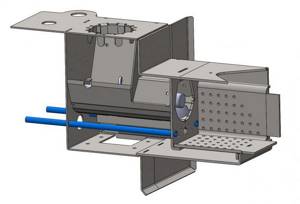
Pellet burner design
It must be remembered that a homemade pellet burner for a boiler will not meet safety requirements without prior control by a specialist, since an ordinary person may not know all the intricacies of the work. The burner must be installed in strict accordance with the regulations.
Also, a burner for a pellet boiler assembled by yourself can be supplemented with an ignition system. It can be manual or automatic. If automatic is selected, you will need to additionally install an electric fan. The torch burner differs from other options in its low power and has compact dimensions convenient for use at home.
The retort burner has the shape of a bowl. It is filled from below. The fan supplies air to the combustion zone, which enters the burner through special small holes.
Methods of supplying fuel to the burner
Purchase
A burner assembled in production conditions will require serious investment. The average cost of a finished product is about 75,000 rubles. The cost is affected by:
- Manufacturer.
- Materials used.
- Dimensions.
- Ignition type.
In order to save money, it is proposed to create a burner with your own hands according to existing diagrams and drawings.
DIY making
A homemade pellet boiler, the drawings of which are selected for work, must correspond to the type of burner. You can also make it yourself. The burner operating in the unit is fireproof. The service life with proper assembly is at least 10-15 years (production options can work up to 20 years). All the tools and components that the burner requires can be purchased at a regular store.
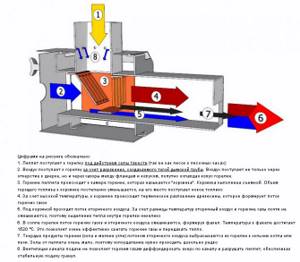
Pellet burner diagram
The parameters should be calculated using a specialist or a special calculator. Video on installation work related to the burner:
Housing and heat exchanger
It is recommended to make the body from fireclay bricks (resistant to high temperatures, overheating and temperature changes). Cast iron is also suitable for this element.
The heat exchanger is created from pipes. They must have a square cross-section. It is necessary to make holes in order to later bring round pipes. The material is sheet steel, the thickness is 4-6 mm. There should be technical doors in the front and rear walls (required for maintenance of the unit). Tools – welding machine and drill.
The heat exchanger, according to the available diagrams, is located inside the boiler body.
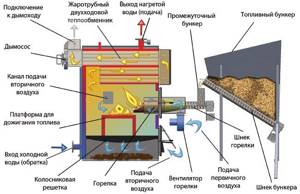
Design example
Firebox
Pellets are poured here and fall into the burner.
Operating procedure:
It is necessary to purchase an auger with a diameter of 7.5 to 10 cm, a metal container and an electric motor. The motor is connected to the burner control unit. You can use any thick-walled casing as a metal container. An inlet pipe is connected to one part of the auger, and a corrugated tube is connected to the second. The fuel supply will pass through it.
Hopper and screw mechanism
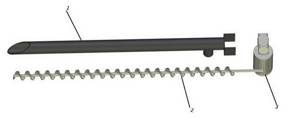
To make your own you will need:
- auger with a diameter of 75 mm or 100 mm,
- metal casing
- a simple electric motor that connects to the burner control unit.
We recommend: Warm floors in the house - types, advantages
The bunker is best made of steel.
Video instruction:
Starting and maintaining the boiler
Before the first launch of the structure, you will need to invite a specialist to check all elements for compliance with safety requirements. It is not recommended to switch it on yourself.
Start-up is carried out only after checking the unit for compliance with the selected scheme. The tightness of the chimney, bunker and the boiler itself must be checked. Before starting, you need to make sure that the heating system is full and the pressure in it corresponds to parameters suitable for operation. All instruments and automation must be in working order.
Caring for the unit is not difficult. As it burns out, it is necessary to add fuel, clean the stove from ash, and also monitor the performance of the automation elements. Separately, you will need to check how the burner and ignition system work.
Installation
The installation method for a homemade pellet boiler is practically no different from the installation of other types of solid fuel equipment. The main task in this case is to correctly place the boiler itself and the fuel supply auger. A distance of 70 cm must be maintained between the individual modules, and 2 meters of free space must be left in front of the boiler itself. The supply of coolant to the heating boiler at the time of its ignition can lead to condensation with ash and soot. It is very difficult to remove. Therefore, during the installation of the boiler, it is connected to the water circuit, in which the mixing unit is built-in.
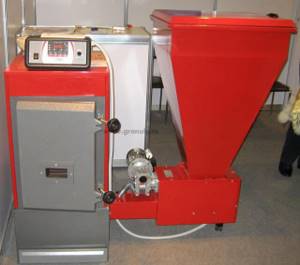
As a rule, a three-way valve is used, which supplies coolant inside the water jacket only after warming up to the appropriate temperature. In this case, the circulation pump forces the water to circulate in a small circle. As soon as it heats up, the three-way valve gradually mixes it into the coolant of the heating circuit until it completely closes the small circle.
Please note that system security must be ensured. It assumes the presence of a pressure sensor and a safety valve installed on the outlet pipe. These measures are mandatory so that the oven can be used without any danger.
In conclusion, we note that the efficiency of industrially produced pellet stoves is much higher. However, homemade devices are much cheaper and more reliable in operation.
Using a pellet burner for a stove
Pellet burners are a universal device that fully automates the fuel supply process and maintains a given temperature.
Today on the market you can find a large number of models that have proven themselves successfully. They can operate both using electrical energy and compressed gas. The first option is safer, since the energy supply can be instantly limited in case of an emergency.
Example of a pellet burner
An important feature of such burners is the automated fuel supply mechanism, which does not require outside intervention. All you need to do is enter the settings, check their correctness, change them to the required values if necessary, and then just monitor the availability of fuel
Modern pellet burners have several main parts, including:
- Transport fuel supply mechanism;
- Ignition and fire control systems;
- Microprocessor for automated control of the combustion process;
- The actual body.
The cost of such products is quite high, but the comfort they provide is worth the money spent!
Design and principle of operation
In a brick oven
Installing a burner in a brick oven is quite simple:
- The burner body itself is inserted into the oven, and then carefully secured with screws and other materials.
- Usually there is no gap between the furnace mouth and the burner wall, however, if there is a large diameter hole, it is recommended to seal it with specialized sealants.
- If the burner is electrically powered, the power cable must be protected from high temperatures. It is usually vented away from the furnace and direct flame exposure, so no additional design modification is required.
- The last step is to secure the pellet storage chamber on top of the burner. The case has a special mechanism, so you only need to install it in the appropriate grooves.
Examples of installation in the photo:
Photo 1
Photo 2
In a metal oven
Installing a pellet burner on a metal stove is practically no different from the brick version
The only thing you should pay attention to is to prevent contact of the burner body with the walls of the furnace, since high temperatures can lead to failure of the mechanism
Installation example
Pellet burner installed in a potbelly stove with a hopper
Pellet loading technique
Heating a simple brick stove with pellets is quite simple. If the burner has an electric ignition mechanism, then you just need to press a special button. Cheaper models do not have this functionality, so a gas burner is used.
The combustion rules are quite simple - fuel should be supplied evenly and fairly slowly. If a large amount of ash is formed, then the feed rate should be reduced, since the pellets simply do not have time to burn, but melt under the influence of high temperature.
Manually firing the stove with pellets
One of the simplest and cheapest formats for using such pellets involves manually adding fuel to the stove. For many people, this process seems unnecessarily complicated and incomprehensible, since the first time it is not possible to calculate the exact amount of fuel and the time of its addition.
After just a few times, you will be able to understand the features of the process and will easily control the flame power and the “operating” combustion temperature.
You can heat a stove with pellets in a conventional stove without significant modifications:
- The easiest way is to install a specialized basket in the oven. It has a fine-mesh structure, which prevents burnt pellets from falling into the ash pit. The cost of such products is extremely affordable, so every stove owner can afford it.
- If you want to do the work yourself without purchasing additional products, you should manually reduce the gaps between the grates. To do this, you need to re-weld the grate with a decrease in clearance or install a special mesh, which is made of thickened wire.
Using a pellet burner for a stove
Modernization of a wood-burning pellet stove by installing a burner device is optimally suited for heat generators operating using long-burning principles. After installing the burner, it is possible to achieve maximum heat transfer and economical consumption of pellets.
Converting the stove from wood to pellets is carried out by installing a mounted or built-in burner connected to a screw transmission and a fuel hopper. The design of the burner device consists of several important elements:
- The operation of an automatic pellet burner is controlled by a microprocessor chip. The controller selects the feed rate of granules and, in the event of an emergency, turns off the operation of the equipment.
- Transport feed – the equipment for organizing the supply of pellets includes: a screw feed, an electric motor. The nodes are connected to a controller that regulates their operation.
- Ignition and flame control system. Ignition is carried out as soon as the system starts. When the flame dies out, the pellets are re-ignited automatically.
A long-burning wood stove converted to pellets is economical. Given the availability of pressed pellets, heating costs are reduced by 30-40%.


The burner has a removable design. A long-burning heating stove operating on pellets and wood can be converted from one type of fuel to another within 10-15 minutes. For modification, there is no need for qualified assistance. It is enough to remove the burner and install the firebox door back.
Installing a pellet burner in a brick stove
Principle of operation
A pellet stove operating on granules consists of the following components:
- Frame.
- Burner.
- Firebox.
- Heat exchanger.
- Fuel bunker.
- Fan.
- Chimney.
The main element of the design is the burner, controlled by an automatic system. Burners are divided into 2 types:
Flare. This is a pipe that is the combustion chamber. In it, on one side, pellets are fed by an auger with a stream of air, and on the other there is a stream of flame.
Retor. The burner is bowl shaped. Fuel is supplied from below by a screw. Air is blown in from the side by a fan. There are holes in the bowl for this purpose. The flame is directed vertically upward.
The burner design has a built-in fan and auger. Electric ignition and combustion process is provided by a photosensor, an incandescent element and a control board.
On command, the screw transfers a portion of granules into the combustion chamber. According to the program, the fan turns on and the incandescent element starts working. A flame appears. As soon as the photosensor detects stable combustion, the control unit stops the incandescent element. Subsequently, the cycles continue according to the specified program.
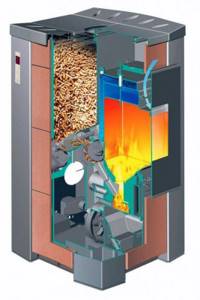
Diagram of a pellet stove inside
The combustion chamber is made of steel or cast iron. The oven has a built-in heat exchanger. It consists of pipes through which smoke and hot gases pass, heating the water. From the heat exchanger there are pipes for connection to the heating system.
Heating with pellets: profitable or not, myths and reviews
Let's consider the most common questions regarding the benefits of heating with pellets, their pros and cons:
- Pellets burn better than firewood, is it really possible that something is added to them and this makes them less environmentally friendly? In fact, this is a fairly common and also erroneous opinion. As mentioned above, only harmless raw materials are used for the production of fuel pellets. For example, substances that do not pose a threat to human health are also used as binders for wood waste.
Answering specifically the question of why pellets burn better than firewood, first of all you need to say this:
Is heating with pellets profitable?
- The density of fuel granules (pellets) is an order of magnitude higher than that of wood;
- The humidity of pellets is lower.
In addition, the structure of the pellets itself contributes to their better combustion. Do not forget that pellets are burned in boilers specially designed for this purpose, with forced air supply.
How many pellets do you need to heat a house?
- You need much less pellets than firewood to heat the same room. Indeed, heating with pellets shows good results in terms of calorific value. For example, just one kilogram of pellets can produce about 5 kW of heat per hour. Considering that to comfortably heat 10 sq/m you need only 1 kW of heat, then with five kilowatts you can heat a small house of 50 square meters.
Heating boiler using pellets
- Will pellets burn in a regular stove or boiler? Without a heating boiler with forced air supply into the combustion chamber, it is quite difficult to use fuel pellets for heating. They will burn, but then we can’t talk about any savings, and the combustion of pellets, in this case, will largely depend on how good the draft in the chimney is.
- Pellets can be stored as much as you like, anywhere, and in any conditions. No, this opinion is wrong, and there are a number of strict requirements for storing pellets. Firstly, pellets are afraid of moisture, which, when it comes into contact with them, is successfully absorbed by the granules, after which they also crumble into pieces and become unsuitable for use. Therefore, pellets should only be stored in dry rooms, avoiding sudden temperature changes in them, in order to avoid the formation of condensation.
Gray or white pellets - which is better?
- 5. Which pellets are better, white or gray? This question is also a common misconception among those who decide to switch to pellet heating.
The color of fuel pellets has nothing to do with their quality, which can only be determined after burning a certain amount of this fuel. And, nevertheless, there are clear visual signs of identifying high-quality and low-quality pellets. So, for example, high-quality pellets should be free of cracks, have a length of at least 7 mm, shine in the light and not crumble if you try to lightly rub them in the palm of your hand.
We recommend: Wall-mounted and other radiators, convectors for the bathroom
Choice for home
Pellet boilers are relatively new equipment. When purchasing, the following parameters are taken into account:
- Power. The minimum value is 10 kW. This is enough to heat 100 sq.m. area. When purchasing a device, you need to take into account a small performance reserve. You can calculate this parameter yourself, keeping in mind the average value: for heating 10 sq.m. the premises consume 1 kW of thermal energy.
- Efficiency The larger it is, the more economical the heating process is. The minimum value is 82%
- Type of water jacket placement. This indicator is important for ensuring fire safety.
- Unit weight.
- Availability of fuel.
- Combustion chamber dimensions. The consumption of pellets depends on them.
- Traction type. It affects the performance of equipment and its placement in the building.
The design of the ash pit and the possibility of its cleaning are also taken into account.
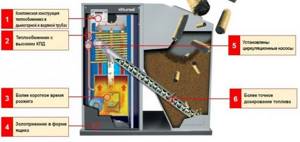
Is it possible to burn a regular stove with pellets?
It was previously mentioned that pellets are extremely active in everyday life, but a special stove and burner system is required to ensure a normal flame and a uniform heat transfer process.
Despite a number of limitations, pellets can be burned without much difficulty in a conventional stove, however, the advantages of fuel in this format of use are often lost.
The main positive features of the material are:
- Long burning life;
- Low emission of smoke and toxic substances;
- High amount of thermal energy;
- Burnout uniformity.
Most often, minor modifications are required according to proven schemes. All of them differ from each other in their complexity, cost of implementation and the need for additional equipment. Despite all the difficulties, already in the first hours after the upgrade you will be able to forget about the difficulties that haunted you earlier.
Mistakes when using pellet stoves
A pellet boiler can be expensive and of high quality, but if the choice of the device was wrong, disappointment is inevitable. The main mistake lies in the general incompatibility of the boiler with the goals of consumers. It is necessary to clearly understand your needs and how much the oven can satisfy them. First of all, equipment must be assessed in terms of its type and selection criteria.
A common mistake is incorrect calculation of boiler power and room heat loss. The result is too low or too high a temperature. It is better to spend more time, but make the right calculations. It’s even better to entrust this to a specialist.
Poor furnace performance is another annoying problem. It is usually connected (if we are not talking about low-quality equipment) with the typical realities for Russia - mentioned by the poor quality of electrical networks and fuel.
Let's briefly list three more possible troubles:
- chimney sparking; the reason is the wrong choice of the latter;
- wood dust flying around the room; the reason is an incorrect choice of location for the stove;
- increased frequency of filling the ash pan; The reason is incorrect setting of the pellet burner.
Which is better to choose – a fireplace or a pellet boiler?
The choice depends on the buyer's personal preferences and desires, but there are several factors that will help make the best decision:
- Cost – a pellet boiler is cheaper than an aqua fireplace.
- Aesthetic value – fireplaces are decorative items that decorate a room. The portals offered in particular by Palazzetti are a real work of art. The boiler is intended exclusively for heating.
- Thermal efficiency - German Hark and MCZ fireplaces have an efficiency of almost 96%, which exceeds the same figure for some boilers. Klover products have a modest 80%.
- Water heating is the main method of supplying hot water for fireplaces, connecting an indirect heating boiler, which requires additional costs. The boilers are equipped with a second circuit for hot water supply.
Fireplace or boiler? Judging by the fact that cost plays a decisive role in making a decision regarding the choice of heating equipment, it is better to buy a boiler. But, if you need not just a heat source, but a separate decorative element, you cannot do without an aqua fireplace.
Choosing a pellet fireplace for heating a frame house
When choosing a pellet boiler, I was horrified by their appearance - such a monster should be placed in a separate room and people who need to be scared should be allowed there on a tour. I didn’t want to have a separate technical room at all: our house is not big. I wanted to have a fireplace with a live fire. So in the evening, turn off the light in the living room and sit on the sofa, drink hot wine, and look at the reflections of the fire on the walls, out of the corner of your eye seeing snowdrifts and snow-covered conifers outside the window.

A solution was found - a pellet fireplace with a water circuit - an aqua fireplace. I also immediately chose the model - Laminox ESTER IDRO 15 “all in one”:
— safety valve — expansion tank — circulation pump — automatic air vent
According to my calculations, a power of 15 kW was enough for a house. But after calling a company that exclusively supplies Italians and deals with connecting and servicing aqua fireplaces, my choice was finally formed: LAMINOX ELISA PHANTOM IDRO 16 - a flat burgundy-colored aqua fireplace with a vertical outlet.
Well, I can now say that the choice was right. The aqua fireplace works quietly - the monotonous rustling of the fan. You can't hear the pellet feeding screws at all.
The chimney is 8 cm - I ordered a 10 cm sandwich, painted brown - it fits into the future interior. The chimney on the roof does not smoke and does not give itself away in any way. Sometimes with a gust of wind you can catch a sweetish aroma - this is what a good Italian liqueur smells like.
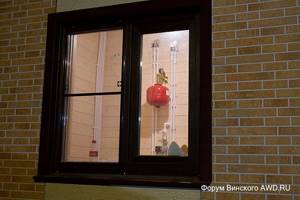
At night I see reflections of flames on the windows of the first floor - while the house is drying and finishing, the aqua fireplace is working around the clock. Consumption of pellets (I bought 2 tons for testing) per day, one bag of 15 kg. In the future it will consume less.
The aqua fireplace is controlled automatically. 5 buttons and menu. You can set the combustion power and the room temperature that the aqua fireplace will maintain.
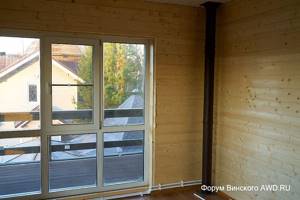
The only inconvenience: the aqua fireplace hopper for pellets is 15 kg. That is, you have to add pellets once a day. Therefore, despite the fact that you can connect an Internet module to the aqua fireplace for remote control of heating (for example, while in Thailand a few days before arrival, set the temperature in the house to 23-24 degrees), this task cannot be realized due to the limited capacity of the bunker.
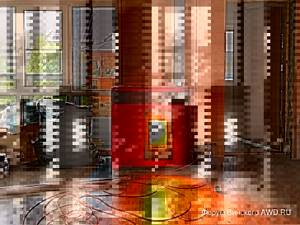
You can come up with something with installing an external bunker and increasing the volume to 200-300 kg, but it won’t be pretty. Therefore, here: - either beauty and aesthetics - or practicality
We chose beauty and aesthetics.

Brands of automatic pellet aqua fireplaces
Aqua fireplaces are produced by leading manufacturers of solid fuel equipment. High-quality products are manufactured in Europe. Judging by customer reviews, the following models are worth purchasing:
- La Nordica Melinda Idro and La Nordica Graziosa Lux Plus are products of the Italian concern, characterized by the constant introduction of new technologies to increase heat transfer and automate the combustion process.
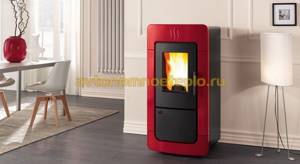
- EdilKamin Detroit and EdilKamin Boston are another example of the Italian approach to solving the problem of automation. Fireplaces operate in completely autonomous mode. The launch is carried out remotely.

- Palazzetti Martina IDRO LUX and Palazzetti Camilla IDRO - the manufacturer offers products made in modern and classic styles. Fireplaces have built-in and attached versions. If desired, cladding panels are supplied as an additional option.
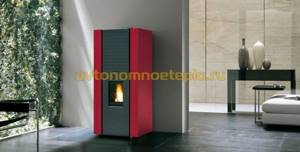
- Klover Diva Plus is the difference between the series and its high thermal efficiency. The main purpose is to heat medium-sized houses.
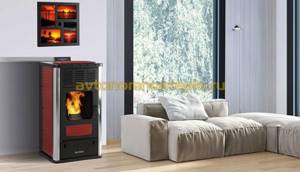
- MCZ Ego Hydro and MCZ Club Hydro - a series of a German brand, are distinguished by high thermal efficiency and efficiency reaching 95.5%. The heat exchanger is made of gray cast iron.
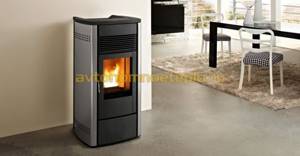
- Hark ProAqua is a representative of the German school that produces solid fuel heating equipment. The models are distinguished by ease of setup and operation, and high operational reliability.
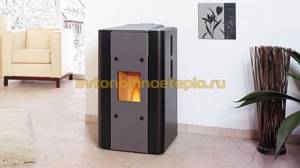
Best models
Fireplace installations Termal
Among the most popular lines of domestic and foreign manufacturers, one of the most inexpensive, high-quality and multifunctional, are termal pellet fireplaces. Today, the line includes about 20 different items.
Fireplace installations are produced in Russia, Italy and Macedonia. The production uses the latest and most innovative equipment.
The main advantages of the termal line include:
- The best and multifunctional equipment manufactured in European factories;
- Affordable cost, which is achieved through assembly work at factories in Macedonia;
- High-quality and high-strength materials ensuring easy use and durability of the structure;
- Possibility of fully autonomous operation in a given mode;
- high power and convenient connection;
- Uniform and efficient heating of the private sector;
- Possibility to use the installation as the main source of heating;
- Impeccable service, availability of all original parts, consumables and components.
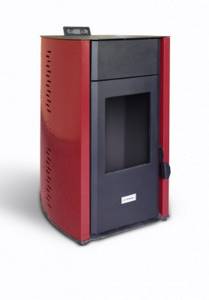
Pellet fireplace Termal
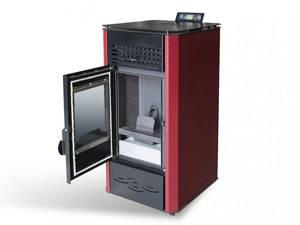
Pellet fireplace for a small living room
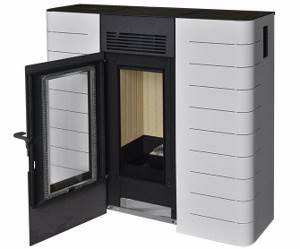
Massive pellet construction
By choosing this type of heating, you get a lot of new opportunities:
- The design is completely ready for use. In order to connect such an installation it will take no more than one day;
- All work is fully automated. Some models can operate without refueling for up to four days. The newest models are controlled via a Wi-Fi Internet connection;
- Availability of a timer and several standard operating modes;
- Thanks to its small overall dimensions and universal design, such a heating structure can be installed in any room: living room, kitchen, bedroom, studio;
- A stationary system allows you to install your own individual chimney for such a unit;
- This line has fully automated control, which allows you to regulate the flow and level of heat, power, time, room temperature;
- The newest models are equipped with a digital interface that allows you to get maximum comfort when using.
Tip: after watching the video, pellet fireplaces, you can familiarize yourself with all the models in the termal line and choose the most suitable option for yourself. You can also learn more about all the most accurate, detailed characteristics and descriptions, as well as buy a fireplace at the lowest prices in our online store.
Usage and operational capabilities
Fireplaces and stoves with a water circuit are intended for installation both in country houses and in private multi-storey buildings. Due to their high efficiency, such fireplaces can serve as the main source of heating. Also, the presence of a water jacket allows you to make a connection in such a way that the house has hot water and a boiler for its regular heating.
A fireplace stove with a water circuit does not depend on the availability of gas and electricity, and thus can be installed even in towns and villages, where interruptions and shutdowns of these resources often occur.
The main features and positive qualities of such installations include:
- Possibility of connection to almost any type of heating system;
- Wide range of prices, brands, models and manufacturers;
- To kindle and operate the structure, you need dried and prepared logs or purchased briquettes;
- The working process is fully streamlined, and the furnace itself can operate in an autonomous and economical mode;
- Each model has its own unique and inimitable style;
- For small rooms, you can choose a corner heating unit;
- Due to the presence of a heat exchanger and a water jacket, heating of the premises occurs very quickly and evenly.
This article presents a large number of photos of various models and installation schemes that will help you make a melting choice and determine the visual qualities of the hearth you need.
Criterias of choice
A fireplace stove with a water circuit can have different characteristics and operational capabilities
Before purchasing, pay special attention to the following criteria:
- Determine the required power of the heating unit. You can visually recognize it based on the size, shape, and location of the hearth. The most powerful are massive cast iron structures that have a wall or island arrangement. You can learn more about this parameter by studying the instructions included with the model. Keep in mind that to heat 10 square meters, you will need about 1 kilowatt;

Steel model, with sidewalls finished with fire-resistant materials
Steel model, with sidewalls trimmed with fire-resistant materials, a hob and firebox equipped with transparent fire-resistant glass

The principle of heating using the example of a two-story house
The principle of heating using the example of a two-story house
- Fireplace stoves with a water circuit can be of both domestic and foreign origin. When choosing, give preference to a proven, well-known brand, the quality of which has been tested by time;
- The installation must be of high quality and durability. As a base material, give preference to cast iron or sheet steel, which is additionally painted with a special protective paint. Such fireplaces are suitable for both regular heating and periodic heating; they can be located in rooms that do not have other heat sources;
- Long-burning fireplace stoves with a water circuit are more suitable for installation in rooms where you live permanently, as well as for houses with a large area and several floors.

Diagram showing the passage of air masses and heated air
Diagram showing the passage of air masses and heated air

Some steel models with a water circuit have average efficiency
Some steel models with a water circuit have average efficiency with small dimensions

